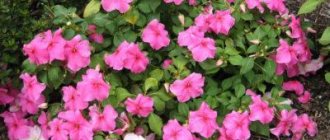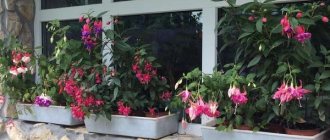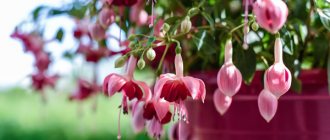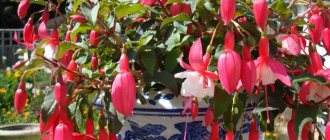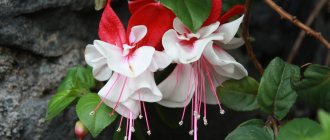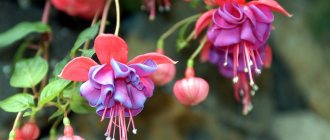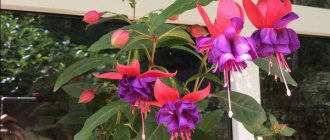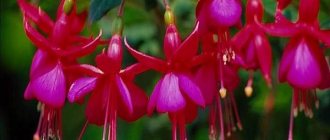Fuchsia is a plant from the genus Willowherb and is a perennial. The flower got its name from the name of Leonart Fuchs, a famous botanist. Widely distributed in Central and South America.
Indoor fuchsia has long been loved by residents almost all over the world. Fuchsia is a bright, very elegant interior decoration. The unusual shape of flowers and fantastic colors will create a harmonious accent in a room of any style. In honor of one of the most popular shades of fuchsia flowers, designers and artists even came up with the same name for the color - fuchsia.
Fuchsia is not only a beautiful decorative element, but also an easy-to-care plant. However, it is still necessary to get to know it better in order to avoid common mistakes and improve health and prolong the life of the flower.
What is it: general description
Fuchsia is an ornamental plant from the fireweed family . These are small trees or shrubs with flexible shoots of a reddish color, medium-sized lacent or ovate leaves located opposite, and numerous flowers of various shapes and colors.
This ornamental crop has a bushy or creeping appearance. A distinctive feature of fuchsia is the flower. It consists of two parts - a corolla-shaped calyx and a bell-shaped or tubular corolla (skirt) of a different color. All parts of the flower are brightly colored.
Fuchsia varieties that have 4-5 petals and a rather small flower are called non-double . Large fuchsias, the corolla of which consists of many petals, are considered terry.
Attention : This culture belongs to the group of unpretentious plants. Fuchsia is easy to care for and grow and perfectly decorates the interior.
Origin: Brief History
Fuchsia is named after the famous German scientist, botanist and physician Leonard Fuchs .
This plant was discovered by Catholic priest Charles Plumier at the end of the 17th century. He traveled across the South American continent in search of medicinal plants and found this plant there. In 1703, in the book Nova Planetarium Americanum Genera, an article about the discovery of a new species was first published. According to the generally accepted version, this date became the “birthday” of fuchsia.
Nuances of care
To give it a beautiful shape and stimulate flowering, fuchsia must be regularly pruned and pinched. The crop tolerates pruning very easily, so it is often formed as a standard plant. To do this, foliage and shoots are regularly removed from the lower part of the stem. However, the formation process is quite long. It usually takes a couple of years.
If necessary, the bushes can be replanted. To do this, use soil consisting of sand, peat, leaf soil and humus, taken in a ratio of 0.5: 1: 1: 1.
Brief answers to frequently asked questions
What are the differences between indoor plants and other types?
In indoor culture, preference is given to hybrid fuchsias . In English they are also called “Hybrid Fuchsia - F. x. Hybrid." These types of plants have collected all the best qualities of the original varieties. Hybrid varieties are unpretentious, resilient and grow very quickly at home.
The most popular and beautiful types of indoor fuchsias are:
- Fuchsia is elegant.
- Fuchsia brilliant.
- Fuchsia Magellanica.
- Fuchsia hybrid.
Is it possible to eat the fruit?
Fuchsia fruits are quite edible . In cooking, they are used to prepare various delicacies: jam, confitures, sweet sauces, liqueurs and fillings for pies. When ripe, the berries are black-purple in color, and cooks often use them to decorate their dishes.
Important : If you are hypersensitive, fuchsia can be harmful to your health. If the flower was treated with pesticides, then eating the fruit is dangerous to health.
Garden species and those that can be kept at home, their photos
To decorate gardens and parks, varieties of large fuchsias that are prone to strong growth are used . They have straight shoots and reach half a meter. Such plants require careful care and long-term shaping. Flowers can be of a wide variety of colors.
Garden fuchsias are represented by the following varieties.
Australian
Australian ones are tall, with rich, bright, large flowers (Matilda, Walsing).
Exotic terry
Exotic double fuchsias - flowers of medium and small size . They have a large selection of shades (Sarah Jane and Florentina).
Sapphires and Diamonds
Sapphires and Diamonds are high-type fuchsias with large flowers, combining white with a variety of brightly saturated blue shades (Capri, Ultramarine and Dark Secret).
Winter-hardy
Winter-hardy fuchsias - survive well under snow, even without shelter (Garden News, Bacon, Konstanz).
Three-leaved
Three-leaved fuchsias have leaves with a red tint, reach half a meter , and the flowers are small, dark coral, collected in racemes. They are also considered a container type (Express and Orient).
Hybrid varieties
Hybrid varieties are very common among indoor fuchsias. There are more than 2000 types of hybrids. They can be divided into bush and hanging.
Ampelous
Ampelous fuchsias are grown in hanging baskets and flowerpots, as they have flexible creeping or drooping shoots . Cascade, Alice Ashton, Imperial Crown, Hollies Beauty are well-known varieties of this species.
Bush
Bush fuchsias are recommended to be fixed on special supports. They are grown in pots or containers. Anabel, Henriette Ernst, Alisson Bell, Armbrough Campbell - varieties of bush fuchsias.
Indoor varieties
Indoor varieties of fuchsias differ in the type of flowers , they are divided into:
- simple - Brutus, Winston Churchill;
- semi-double - Satellite, Tennessee Walts;
- terry - Midge, Fashion, Swingtime;
- racemes - Yellow, Swanley, Leverkusen.
Does it bloom in winter?
Fuchsia can bloom in September and even until the end of autumn in warm weather. In winter, this crop enters a dormant period. To ensure normal wintering, it is necessary to place the fuchsia in a cool place and limit watering. Storage in the basement is suitable for this.
Is it perennial?
Fuchsia is a perennial shrub . Tolerates wintering well at home. The decorative properties of some varieties do not appear in the first year. There are varieties that reveal their potential in the second year of life. Garden fuchsias that are afraid of frost are brought indoors for the winter, observing the appropriate temperature conditions (find out how to preserve fuchsia in winter here). Pruning is carried out in the second half of winter, after which new shoots should appear. In spring, the flower must be propagated by cuttings.
Ampelous fuchsia
One of the most popular varieties of fuchsia is ampelous. It has a number of features that appeal to many gardeners. For example, it has very flexible stems that cascade down. They are strewn with bright flowers that attract the eye. Pink fuchsia looks very beautiful, as well as its two-color varieties. These hanging flowers are most often grown in pots and hanging baskets.
How to grow at home?
You can grow fuchsia at home from seeds. They are placed immediately in a container with specially prepared soil or in a peat tablet. Shoots appear in 20-30 days. After a pair of true leaves appear, the seedlings are transplanted into separate pots. During the period of growing up, it is necessary to regularly remove the top, that is, pinching. This will help form the bush. This fuchsia should bloom in the second year.
Tip : The soil for growing fuchsias from seeds should be slightly moist, but not wet.
Reproduction
A photo of hybrid fuchsia flowers allows you to appreciate the beauty of the culture. Typically, gardeners grow it as a perennial. But sometimes after a while it is necessary to renew the bushes, since it is not always possible to create optimal conditions. The plant tends to shed its leaves. In this case, the branches of the bushes are left without greenery. At the same time, the decorative quality of the plant suffers. In addition, this negatively affects the fuchsia itself.
There are two ways to propagate the crop: seeds and cuttings. The first method is rarely used. Firstly, it is more complex, and secondly, the new plant obtained from seeds differs in its characteristics from the hybrid fuchsia of the mother bush.
Therefore, it is customary to propagate the crop by herbaceous cuttings. The procedure is carried out at the end of March or beginning of April. For this, apical cuttings (7-10 cm long) are used, the surface of which has not yet become roughened. For rooting, shoots are placed in a container of water or in moist soil with a neutral pH level. The top of the cutting is covered with a glass jar.
Gardeners note that rooting takes about two weeks. The success of reproduction can be judged by the green leaves growing on the top of the head. Subsequently, the rooted plants are planted one at a time in separate pots of larger volume. Experienced experts recommend using peat cups for rooting, since during further replanting the root system of the hybrid fuchsia will not be injured.
When can I transplant it outside?
When the rhizome develops and grows throughout the pot, the fuchsia is planted outdoors . By that time, the flower should have several shoots with leaves. Fuchsias love morning sun, so it is best to plant them on the east side. Although there are varieties that need shade in the afternoon.
Fuchsia is planted in a hole half filled with compost. It is good to do this by transshipment, that is, the plant is taken from the pot along with the soil. The walls of the hole are also filled with compost. Find out how to grow fuchsia, including in the garden, here.
Trimming
It is advisable to prune plants 2 times a year. The first pruning is carried out after flowering (at the end of October). First, those branches located in the axils that have already bloomed are removed, then the flower stalks and seed pods.
The second pruning is carried out in winter (in January) - first, excess shoots are cut off, thereby forming a crown. If you want to form a hanging bonsai from Fuchsia, then leave only one or a few shoots for further formation of a bonsai in the form of braids. It is also important to pinch the tops of the shoots in order to subsequently form a lush crown of the flower.
How to properly care for it and make it produce buds?
- Light . Fuchsias develop well in artificial and natural light. But there must be enough light. Otherwise, the plant will stretch out and will not bloom.
- Temperature . In summer, the optimal temperature for fuchsia is 18-20 degrees. In hot weather, it is better to take the flower outside. In winter, the temperature drops to 8-10 degrees.
- Watering . Regular, abundant but moderate watering should be provided. In winter it is significantly reduced. Spraying and washing are done periodically. Water for irrigation must be settled.
- Fertilizer . For full growth and flowering, you need to fertilize the flower once every two weeks with special fertilizers for flowering plants. Such options as “Peters”, “Kemiru” are suitable. In winter there is no need for fertilizing.
- Trimming . Pruning or pinching is a prerequisite for proper care of these flowers. Pinching begins at the cutting stage and lasts throughout the life of the fuchsia. It is preferable to do this procedure in the spring, before the flowering period. To form a bush, you need to pinch the side shoots after 3 or 4 pairs of leaves.
- Reproduction . It is recommended to combine propagation with pruning. Cuttings are rooted in water or directly in the ground. Rooting time ranges from several days to a month, and depends on various factors. It is advisable to periodically spray shoots that take root. Learn more about fuchsia propagation. including about growing from a leaf, we talked here.
Read more about the basic rules for caring for fuchsia at home here.
How to replant?
The annual replanting of fuchsia is carried out in the spring. First, a drainage layer is created (expanded clay can be used). A little soil mixture (leaf soil, humus, peat) is poured onto the drainage. Carefully transfer the flower with a lump of earth to the prepared place. The remaining earthen mixture fills the voids in the pot.
The transplanted plant is placed indoors or on a window with sufficient light, watered well, sprayed and the shoots are cut by a third.
We recommend watching a video about replanting and pruning fuchsia:
Monochrome look
When choosing monochrome sets, fans of magenta are recommended to combine different shades of color. For example, classic fuchsia trousers are worn with a purple top. A plum dress will complement a jacket that is a couple of shades lighter.
Choose shoes and handbags that are several tones darker than the main part of the look. So, pair dark sandals or ballet shoes with a bright dress.
In clothes of the same color scheme, it is permissible to use details of a different color. Shoes, a clutch, a scarf or a headdress become an accent part.
Why doesn't it bloom?
Flowering is usually profuse with proper care. There are a number of factors influencing the lack of flowering of fuchsia :
- not enough light;
- temperature too high;
- incorrect amount of fertilizer;
- pruning done late;
- poor conditions for wintering the plant;
- a pot of inappropriate volume (until the root system covers the entire pot, the fuchsia will not bloom).
We recommend looking at why fuchsia does not bloom:
Fuchsia trifolia
Let's talk about some varieties of fuchsia and their characteristics. The first variety is a bush up to 60 cm high. The leaves of the plant are small, ovoid, only 8 cm in length. The flowers resemble bells in appearance. The inflorescences are formed by small fiery red buds. Abundant flowering begins in May and ends in October. Three-leaved fuchsia is relatively unpretentious: in the summer months it can withstand high temperatures and exposure to direct sunlight. Ideal for growing as part of flower arrangements.
Signs and superstitions
Every plant has some kind of superstition associated with it. Is it good or bad for this plant to be at home? As for fuchsia, many positive qualities are attributed to it.
When this plant is in a house or apartment, it:
- helps develop intuition and creative skills;
- harmonizes the energy in the room;
- supports health in those who suffer from diseases of the thyroid gland and digestive system;
- promotes mutual understanding between children and parents;
- drives away apathy and helps find a way out in a difficult situation;
- adds cheerfulness;
- makes its owner irresistible and charming.
There is also a superstition that fuchsia is a widow's flower . But, despite this, the flower is so luxurious and charming that almost none of the female flower growers attach importance to this strange statement.
Evening look
Fuchsia-colored clothes are the ideal solution for a celebration. However, remember that this color palette is active, and the outfit does not need excessive decoration, intricate draperies and unusual cuts. Avoid layers, flounces, sequins and embroidery, which overload the look.
An evening dress in rich colors is worn by bold and relaxed fashionistas. The choice of style and length depends on personal preferences and body type. For those with large breasts, models with a sweetheart neckline are suitable. Stylists advise girls with small breasts to purchase a model with a deep neckline.
For slender fashionistas, a sheath dress or an option with a full skirt will suit you. And a model with a high waistline will hide extra pounds. Silver or black heels and a matching clutch will complete the look. As for jewelry, dainty earrings and a couple of bracelets are enough.
Diseases and pests
With proper care, strong immunity protects fuchsia from diseases and resists pests. However, there are a number of diseases that can affect your plant.
Powdery mildew is characterized by a pronounced white coating and the appearance of liquid droplets.- Gray rot makes the plant watery and soft. A plaque appears on the leaves. The cause is too humid air.
- Rust appears as brown spots, spreads very quickly and requires immediate treatment. If you keep the flower in the required microclimate, you can avoid the use of drugs and preserve the plant.
Fuchsia can also be affected by pests such as whiteflies, spider mites and aphids. To cure the plant it is necessary to use insecticides.

